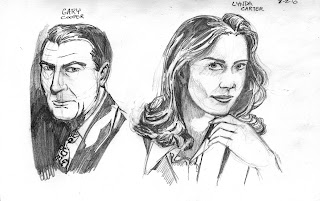
Every now and then, I get on an Andrew Loomis kick. In my opinion, Loomis is one of--if not the--greatest figure artists of all time. He's certainly the best artist to learn from, because he literally wrote the book(s) on drawing people. Anyway, this time, I was looking at some diagrams he made of the human face, and tried to mimic it in drawing from photos. Fair warning to the person that draws from a photo: modern photos of celebrities and models are often digitally adjusted. You also have to remember that plastic surgery and makeup are miracle-workers these days. A good digital artist, makeup artist, or doctor won't manipulate a person's face making them look too different from what they actually are, or create physical impossibilities, but just be on the lookout. If you're doing a serious illustration, I definitely recommend the use of video and candid shots of people, as opposed to ads or glamour shots. For these sketches, I didn't really care too much, so the pictures I got were idealized in various ways.
The drawing of Gary Cooper was the easiest. Drawing men--especially as they get older--is much more forgiving for me, because I feel like if the lines aren't perfect, it's okay. Lines on a face denote age, so you can get away with a little more.
Lynda Carter took about 3-4 times longer to draw; I even had to use a lightbox to help with her lips a little. And I'm still not 100% happy with how it turned out, because I don't think it really looks like her. Drawing women for me is always difficult, because it's just the opposite of...um...men. Efficiency of line is of the utmost importance. One stray line, and it changes the image or makes them look old.
I learned recently that humans recognize faces by abstraction, as opposed to creating an exact image in our imagination. I think I got this with the Gary Cooper image. It doesn't look exactly like him, but I caught his long nose, square chin, and wide mouth. Loomis' diagram helps to place everything properly on the face. There are diagrams for the human face that chart every contour of it, and some of it is pretty wild how basically similar we all are.



 I came across this Dennis the Menace strip today, and was happy to find that it was very similar to a sketch I did just the other night. Though usually suited for the process of animation, it's important for any artist to have a solid understanding of how a motion is executed, step by step. In my case, I was trying to draw the final dip in a waltz, but I couldn't figure out how exactly the dancers got into that position. So, I backed up the video and drew them as they got there. Preston Blair, in his book Cartoon Animation, goes into great detail about the stages in lots of different motions (walking, running, sneaking, jumping, etc.).
I came across this Dennis the Menace strip today, and was happy to find that it was very similar to a sketch I did just the other night. Though usually suited for the process of animation, it's important for any artist to have a solid understanding of how a motion is executed, step by step. In my case, I was trying to draw the final dip in a waltz, but I couldn't figure out how exactly the dancers got into that position. So, I backed up the video and drew them as they got there. Preston Blair, in his book Cartoon Animation, goes into great detail about the stages in lots of different motions (walking, running, sneaking, jumping, etc.). 























